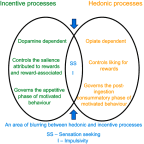Could the link between drug addiction in adulthood and substance use in adolescence result from a blurring of the boundaries between incentive and hedonic processes?
- PMID: 31372088
- PMCID: PMC6634303
- DOI: 10.2147/SAR.S202996
Could the link between drug addiction in adulthood and substance use in adolescence result from a blurring of the boundaries between incentive and hedonic processes?
Abstract
There is a broad consensus that the development of drug addiction in adulthood is closely linked to the onset of drug use in adolescence. However, the relationship between drug exposure during adolescence and subsequent vulnerability to addiction is yet to be fully understood. This review will first use evidence from adult studies on reward and addiction to give an up-to-date reference point of normal reward-circuitry and the maladaptive changes that later occur in addiction. This will then be compared with current evidence from adolescent studies on reward-circuitry. Similarities between the reward processes governing characteristic behavioral traits in adolescence and the reward profile in adult addiction could help to explain why the risk of later developing addiction is increased when substance use is initiated in adolescence. We argue that the age of onset is a major risk factor in the development of substance use disorder due to a blurring of the boundaries between incentive and hedonic processes, which occurs during adolescence. A deeper understanding of the processes that mediate this blurring could open new avenues for the prevention and treatment of adult drug addiction.
Keywords: addiction; compulsive; dopamine; impulsive; opiate.
Conflict of interest statement
The authors report no conflicts of interest in this work.
Figures


Similar articles
-
Maladaptive Decision Making in Adults with a History of Adolescent Alcohol use, in a Preclinical Model, Is Attributable to the Compromised Assignment of Incentive Value during Stimulus-Reward Learning.Front Behav Neurosci. 2017 Jul 25;11:134. doi: 10.3389/fnbeh.2017.00134. eCollection 2017. Front Behav Neurosci. 2017. PMID: 28790900 Free PMC article.
-
The psychology and neurobiology of addiction: an incentive-sensitization view.Addiction. 2000 Aug;95 Suppl 2:S91-117. doi: 10.1080/09652140050111681. Addiction. 2000. PMID: 11002906 Review.
-
Modulation of meso-limbic reward processing by motivational tendencies in young adolescents and adults.Neuroimage. 2016 Apr 1;129:40-54. doi: 10.1016/j.neuroimage.2015.12.005. Epub 2015 Dec 12. Neuroimage. 2016. PMID: 26690806 Free PMC article.
-
Reward loss and addiction: Opportunities for cross-pollination.Pharmacol Biochem Behav. 2017 Mar;154:39-52. doi: 10.1016/j.pbb.2017.02.001. Epub 2017 Feb 4. Pharmacol Biochem Behav. 2017. PMID: 28174137 Review.
-
Antireward, compulsivity, and addiction: seminal contributions of Dr. Athina Markou to motivational dysregulation in addiction.Psychopharmacology (Berl). 2017 May;234(9-10):1315-1332. doi: 10.1007/s00213-016-4484-6. Epub 2017 Jan 3. Psychopharmacology (Berl). 2017. PMID: 28050629 Review.
Cited by
-
Substance Use Patterns and Characteristics Using Real World Data from Adolescents Assessed for Substance Use and Treatment Planning-United States, 2017-2021.Subst Use Misuse. 2024;59(13):1839-1859. doi: 10.1080/10826084.2024.2383609. Epub 2024 Jul 29. Subst Use Misuse. 2024. PMID: 39072503 Free PMC article.
-
Decreasing brain activity caused by acute administration of ketamine and alcohol - A randomized, controlled, observer-blinded experimental study.Front Pharmacol. 2024 Oct 16;15:1456009. doi: 10.3389/fphar.2024.1456009. eCollection 2024. Front Pharmacol. 2024. PMID: 39478968 Free PMC article.
References
-
- Kloep M, Hendry LB, Taylor R, Stuart-Hamilton I. Health in adolescence: a lifespan perspective In: Development from Adolescence to Early Adulthood: A Dynamic Systemic Approach to Transitions and Transformations. Psychology Press: 2016:74–96.
-
- Steinberg LD. The adolescent brain In: Adolescence. NY: McGraw-Hil; 2010.
-
- Coleman JC. The Nature of Adolescence. UK: Routledge; 2011.
Publication types
LinkOut - more resources
Full Text Sources

